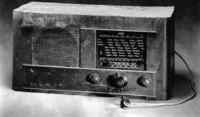Overview
- Brief Narrative
- Wooden tailboard or travel camera with a rotating bellows for capturing horizontal and vertical photographs made in Europe around the turn of the 20th century. This type of camera has a hinged base or tailboard, allowing for rear focusing with a ground glass back. Once the focus is fixed, the glass is replaced with a glass plate negative. This variant of tailboard camera is also known as a continental view due to its equally wide front and body sections. Travel cameras were developed for use by professional photographers outside the studio. The design was perfected in Germany, where they are called Reisekamera, but often produced in other central European countries including France, where they are known as Chambre de Voyage. They were especially popular between 1895 and 1914.
- Date
-
manufacture:
approximately 1890
- Credit Line
- United States Holocaust Memorial Museum Collection
- Markings
- front, interior, top center, engraved : 83
Physical Details
- Classification
-
Audiovisual and Photographic Materials
- Category
-
Cameras
- Object Type
-
Travel camera (ushmm)
- Physical Description
- Rectangular, brown wooden plate camera with a telescoping green and black leather bellows and brass colored metal fittings. On the fixed, L shaped front is a central hole ringed by a wooden mount for a lens, now missing, with a flat, corroded metal band and a metal knob and threaded metal post above. It is attached to the movable center body by the bellows and to the back by 2 butterfly hinges. On top of the body, there are 3 small holes and a flat, pivoting metal tab. On the exterior back is a flat metal hook above a small nail, a circular hole, and a threaded metal tripod mount. The back folds down to form a base with 2 parallel metal strips, with 3 aligned sets of 2 slots, screwed to a center panel. The body of the camera has a hinged, removable translucent ground glass focusing back. To focus this, it is manually pulled over the base until 4 nails on the bottom or the left side slide into the slots, locking it in place on the panel, with the bellows extended vertically or horizontally. A metal knob on each side of the base moves the panel along a metal rack and pinion.
- Dimensions
- overall: Height: 7.375 inches (18.733 cm) | Width: 6.000 inches (15.24 cm) | Depth: 3.750 inches (9.525 cm)
- Materials
- overall : wood, metal, glass, leather, paint, cloth, adhesive, varnish
Rights & Restrictions
- Conditions on Access
- No restrictions on access
- Conditions on Use
- No restrictions on use
Keywords & Subjects
- Geographic Name
- Germany--Social life and customs.
Administrative Notes
- Legal Status
- Permanent Collection
- Provenance
- The camera was acquired by the United States Holocaust Memorial Museum in 1990.
- Funding Note
- The cataloging of this artifact has been supported by a grant from the Conference on Jewish Material Claims Against Germany.
- Record last modified:
- 2022-07-28 18:21:32
- This page:
- https://collections.ushmm.org/search/catalog/irn4122
Download & Licensing
In-Person Research
- By Appointment
- Request 21 Days in Advance of Visit
- Plan a Research Visit
- Request to See This Object
Contact Us
Also in Prewar German travel camera and tabletop radio collection
The collection consists of a wood encased Reisekamera and an AEG 28W tabletop radio manufactured in Germany.
Date: approximately 1890-1938

AEG 28W radio receiver for long wave and broadcast signals
Object
AEG 28W tabletop radio manufactured by the German company AEG (Allgemeine Elektricitaˆts-Gesellschaft), a pioneer in electrical power engineering and a worldwide supplier of electrical equipment and systems. AEG factories were essential to the production of aircraft, automobiles, and railways. In 1933, AEG provided financial support for the newly formed Nazi government. The company initially resisted the antisemitic racial policies of the Nuremberg Laws of 1935 and retained Jewish employees, including members of the managing board. But in 1936-37, facing financial difficulties, the company complied with Nazi policy. By 1943, AEG was an integral part of the war economy. It was a major consumer of slave labor from the ghettos and camps, locating factories near sites such as Riga, Latvia, and Auschwitz III with ample labor supplies. The company voluntarily made reparation payments in 1960.



